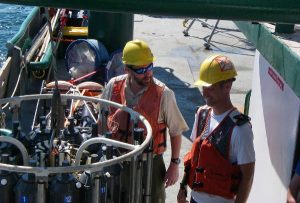Teachers Learning Spill Research Science at Sea
– September 19, 2013
Middle and high-school teachers in Florida, USA, recently put their sea legs to the test when they boarded the R/V Weatherbird II to conduct science that matters to their students and communities.
(From SPILL International) — They worked with scientists to understand the impacts of the Deepwater Horizon oil spill. While gaining hands-on experience, teachers blogged and Skyped to share their learning and allow others to join them on their adventures virtually. Back on shore, teachers created classroom materials based on their experiences.
The Center for Integrated Modeling and Analysis of the Gulf Ecosystem (C-IMAGE) research consortium, led by the University of South Florida, hosts a Teacher at Sea Program. C-IMAGE expeditions collect marine data – from sea-surface plankton to deep-sea microbes in sediments – to answer questions about long-term oil spill impacts and understand the Gulf system.
This year’s participants were Matt MacGregor (Escambia High School), Mary St. Denis (Winter Haven High School), Elisabeth McCormack (Dr. John Long Middle School), and Kathryn Blysma (Dunedin Highland Middle School). Their blogs depict life at sea and the academic rigor and challenges that go into planning and implementing sea experiments.
Enthusiastic Teachers
Some teachers expressed their enthusiasm through creative cartoon-style story-telling. Elizabeth McCormack created a skit filled with “characters” (real people on the vessel) and “action” (their at-sea research).
Part of the learning involves sea technology. This year, C-IMAGE tested the SIPPER 4 (Shadow Image Profiler and Evaluation Recorder), a small “Rubik-cube size” underwater high resolution camera that goes deeper than earlier devices. It takes pictures of plankton and collects data on physical conditions. McCormack said the most exciting part was its internet connection ability.
College students are on board and they gave teachers insights on the value of hands-on learning. Blysma wrote about Joe, an undergraduate student, who had no interest in school until he went to an environmental centre in his district. There, his whole outlook on learning changed.
Different smells
Teachers experienced the evolving nature of science discovery when a routine task – collecting bottles of seawater – took on greater importance, becoming as McCormack said “one of the most important missions on this cruise.” They found one sample from deep Gulf waters that looked and smelled different and determined that it contained much less salt than water from that depth does normally.
They hypothesised about freshwater sources, including the Mississippi River outflow into the Gulf. Scientists will run additional tests at their home labs and look for an explanation.
Field work reminded teachers that answering big questions requires a systematic process that takes time.
C-IMAGE scientists use Skype to visually and verbally share their scientific missions in real-time with the K-12 community. One online demonstration was with 90 third graders at Jamerson Elementary School in St. Petersburg, Florida. They toured the boat, saw researchers retrieve bongo nets and collect plankton samples, and spoke with science experts and crew members.
“GoMRI In the news” is a reposting of articles about GoMRI-funded research (published by various news outlets). The author’s interpretations and opinions expressed in these articles is not necessarily that of GoMRI.






